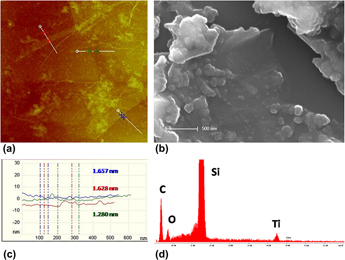Crossref Citations
This article has been cited by the following publications. This list is generated based on data provided by
Crossref.
Morales-Torres, Sergio
Pastrana-Martínez, Luisa M.
Figueiredo, José L.
Faria, Joaquim L.
and
Silva, Adrián M. T.
2012.
Design of graphene-based TiO2 photocatalysts—a review.
Environmental Science and Pollution Research,
Vol. 19,
Issue. 9,
p.
3676.
Lv, Tian
Pan, Likun
Liu, Xinjuan
Lu, Ting
Zhu, Guang
Sun, Zhuo
and
Sun, Chang Q.
2012.
One-step synthesis of CdS–TiO2–chemically reduced graphene oxide composites via microwave-assisted reaction for visible-light photocatalytic degradation of methyl orange.
Catalysis Science & Technology,
Vol. 2,
Issue. 4,
p.
754.
Xu, Chao
Yuan, Yao
Yuan, Rusheng
and
Fu, Xianzhi
2013.
Enhanced photocatalytic performances of TiO2-graphene hybrids on nitro-aromatics reduction to amino-aromatics.
RSC Advances,
Vol. 3,
Issue. 39,
p.
18002.
Gao, Yong
Hu, Meng
and
Mi, Baoxia
2014.
Membrane surface modification with TiO2–graphene oxide for enhanced photocatalytic performance.
Journal of Membrane Science,
Vol. 455,
Issue. ,
p.
349.
Li, Haibo
Liang, Sen
Li, Guolong
He, Lijun
and
Li, Jin
2014.
Visible-light assisted reduction of graphene oxide and its potential applications in water treatment.
Functional Materials Letters,
Vol. 07,
Issue. 02,
p.
1450015.
Zhang, Yong‐Lai
Guo, Li
Xia, Hong
Chen, Qi‐Dai
Feng, Jing
and
Sun, Hong‐Bo
2014.
Photoreduction of Graphene Oxides: Methods, Properties, and Applications.
Advanced Optical Materials,
Vol. 2,
Issue. 1,
p.
10.
Zhang, Wei
and
Jia, Baoping
2015.
Toward anti-fouling capacitive deionization by using visible-light reduced TiO2/graphene nanocomposites.
MRS Communications,
Vol. 5,
Issue. 4,
p.
613.
Fernández-Ibáñez, P.
Polo-López, M.I.
Malato, S.
Wadhwa, S.
Hamilton, J.W.J.
Dunlop, P.S.M.
D’Sa, R.
Magee, E.
O’Shea, K.
Dionysiou, D.D.
and
Byrne, J.A.
2015.
Solar photocatalytic disinfection of water using titanium dioxide graphene composites.
Chemical Engineering Journal,
Vol. 261,
Issue. ,
p.
36.
He, Gang-Ling
Zhong, Yan-Hao
Chen, Ming-Jie
Li, Xin
Fang, Yue-Ping
and
Xu, Yue-Hua
2016.
One-pot hydrothermal synthesis of SrTiO3-reduced graphene oxide composites with enhanced photocatalytic activity for hydrogen production.
Journal of Molecular Catalysis A: Chemical,
Vol. 423,
Issue. ,
p.
70.
Wang , Xiaozhou
Jia , Baoping
Zhang , Wei
Lin, Bencai
Wang , Qiuze
and
Ding, Jianning
2016.
Developing Modified Graphene Oxide Based Sensor for Lead Ions Detection in Water.
ChemistrySelect,
Vol. 1,
Issue. 8,
p.
1751.
Lian, Yiren
Zhu, Wenkun
Yao, Weitang
Yi, Huan
Hu, Zuowen
Duan, Tao
Cheng, Wencai
Wei, Xianfeng
and
Hu, Guozhen
2017.
A biomass carbon mass coated with modified TiO2 nanotube/graphene for photocatalysis.
New Journal of Chemistry,
Vol. 41,
Issue. 10,
p.
4212.
Fathizadeh, Mahdi
Xu, Weiwei L.
Zhou, Fanglei
Yoon, Yeomin
and
Yu, Miao
2017.
Graphene Oxide: A Novel 2‐Dimensional Material in Membrane Separation for Water Purification.
Advanced Materials Interfaces,
Vol. 4,
Issue. 5,
Wang, Qiuze
Jia, Baoping
Zhang, Wei
Liu, Hui
Min, Xiaobo
Ding, Jianning
Maluangnont, Tosapol
and
Wu, Xiang
2017.
Multilayered graphene/ZnFe2O4 hybrid composite: Rational preparation,
characterization and superior adsorption of Congo red.
Veruscript Functional Nanomaterials,
Vol. 1,
Issue. ,
p.
1.
Lin, Lu
Wang, Huiyao
and
Xu, Pei
2017.
Immobilized TiO2-reduced graphene oxide nanocomposites on optical fibers as high performance photocatalysts for degradation of pharmaceuticals.
Chemical Engineering Journal,
Vol. 310,
Issue. ,
p.
389.
Zhang, Wei
Jia, Baoping
and
Furumai, Hiroaki
2018.
Fabrication of graphene film composite electrochemical biosensor as a pre-screening algal toxin detection tool in the event of water contamination.
Scientific Reports,
Vol. 8,
Issue. 1,
Zhang, Yiming
Zhang, Wei
and
Cházaro-Ruiz, Luis F.
2018.
Porous PVDF/PANI ion-exchange membrane (IEM) modified by polyvinylpyrrolidone (PVP) and lithium chloride in the application of membrane capacitive deionisation (MCDI).
Water Science and Technology,
Vol. 77,
Issue. 9,
p.
2311.
Wang, Lue
Zhang, Wei
Samavat, Siamak
Deganello, Davide
and
Teng, Kar Seng
2020.
Vertically Aligned Graphene Prepared by Photonic Annealing for Ultrasensitive Biosensors.
ACS Applied Materials & Interfaces,
Vol. 12,
Issue. 31,
p.
35328.
Jiang, Yuxin
Alhassan, Sikpaam Issaka
Wei, Dun
and
Wang, Haiying
2020.
A Review of Battery Materials as CDI Electrodes for Desalination.
Water,
Vol. 12,
Issue. 11,
p.
3030.
Long, Xiaojun
Duan, Li
Weng, Wenjian
Cheng, Kui
Wang, Daping
and
Ouyang, Hongwei
2021.
Light-induced osteogenic differentiation of BMSCs with graphene/TiO2 composite coating on Ti implant.
Colloids and Surfaces B: Biointerfaces,
Vol. 207,
Issue. ,
p.
111996.
Jafari, Abbas
Sadeghi, Mehrban
Tirgir, Farhang
and
Barghaei, Mehdi
2021.
Photocatalytic removal of naphthalene (C10H8 ) from aqueous environments using sulfur and nitrogen doped titanium dioxide (TiO2 -N-S) coated on glass microbullets in presence of sunlight.
Journal of Shahrekord University of Medical Sciences,
Vol. 23,
Issue. 1,
p.
34.





